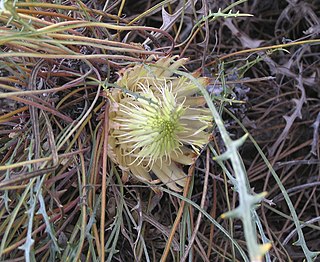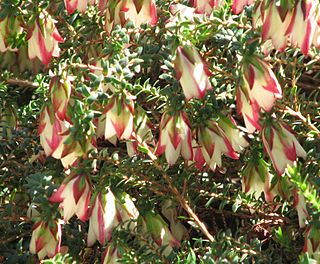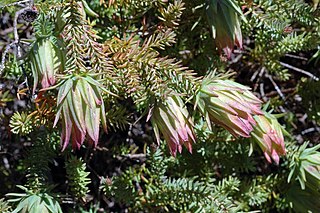
Darwinia, sometimes commonly known as mountain bells or simply bells, is a genus of about 70 species of evergreen shrubs in the family Myrtaceae, endemic to southeastern and southwestern Australia. The majority are native to southern Western Australia, but a few species occur in South Australia, New South Wales and Victoria. The genus was named in honour of Erasmus Darwin, grandfather of Charles Darwin by Edward Rudge in 1816. Most darwinias grow to a height of between 0.2 and 3 m, and many are prostrate shrubs. Most have small, simple leaves and the flowers are often grouped together, each flower with five red, white or greenish petals and ten stamens. In many species, the flowers are surrounded by large, colourful bracts, giving rise to their common names.

Banksia rufa is a species of prostrate shrub that is endemic to the south-west of Western Australia. It has broadly linear, pinnatifid or pinnatipartite leaves with between five and twenty lobes on each side, yellow, orange or brownish flowers in heads of forty or more, and glabrous, egg-shaped follicles.

Banksia splendida, commonly known as shaggy dryandra, is a species of shrub that is endemic to the southwest of Western Australia. It has sharply-pointed linear leaves that are woolly on the lower surface, cream-coloured and maroon or yellow flowers in heads of between 65 and 115, and later up to eight egg-shaped follicles in each head.
Banksia tortifolia is a small, spreading, prostrate shrub that is endemic to the southwest of Western Australia. It has short underground stems, pinnatipartite leaves with sharply-pointed, linear lobes on each side, greenish-cream, yellow and pink flowers in heads of about eighty, and glabrous, egg-shaped follicles.

Darwinia macrostegia, commonly known as Mondurup bell, is a species of flowering plant in the family Myrtaceae and is endemic to the south-west of Western Australia. It is a straggly shrub with elliptic leaves and clusters of pendent flowers surrounded by red and white bracts.

Grevillea obtusifolia, commonly known as obtuse leaved grevillea, is a species of flowering plant in the family Proteaceae and is endemic to the south-west of Western Australia. It is a spreading to dense, prostrate shrub with oblong to narrowly elliptic leaves and clusters of eight to twelve, pink or red flowers.

Darwinia citriodora, commonly known as lemon-scented darwinia or lemon scented myrtle, is a plant in the myrtle family Myrtaceae and is endemic to the south-west of Western Australia. It is a shrub with oblong to lance-shaped leaves and red, yellow and orange flowers over an extended period. It is a hardy plant in well-drained soil, is often cultivated and used as a rootstock for less hardy species.
Verticordia verticordina is a flowering plant in the myrtle family, Myrtaceae and is endemic to a small area near the coast of the south-west of Western Australia. It is a small, low-growing shrub with crowded leaves and in spring, scattered pale greenish-cream and golden brown flowers. Its unusual flowers and fleshy leaves give the plant a superficial resemblance to a Darwinia.

Darwinia grandiflora is a flowering plant in the family Myrtaceae. It is a dense, mat forming, prostrate shrub with clusters of tubular red flowers and is endemic to New South Wales.

Darwinia diosmoides is a species of flowering plant in the myrtle family Myrtaceae and is endemic to the south-west of Western Australia. It is a dense, erect shrub with linear leaves and more or less spherical heads of white flowers.

Darwinia virescens, commonly known as the Murchison darwinia, is a plant in the myrtle family Myrtaceae and which is endemic to a small area on the west coast of Western Australia near Geraldton.

Isopogon buxifolius is a species of plant in the family Proteaceae and is endemic to the south-west of Western Australia. It is an upright shrub with egg-shaped to elliptic or oblong leaves and clustered spikes of pink flowers.

Darwinia helichrysoides is a species of flowering plant in the myrtle family Myrtaceae and is endemic to a small area in south-west of Western Australia. It is a slender shrub with linear leaves and drooping heads of about 4 red and green flowers surrounded by many glabrous bracts.

Darwinia oederoides is a species of flowering plant in the family Myrtaceae and is endemic to the south-west of Western Australia. It is a low, spreading shrub with linear leaves and clusters of pendent flowers surrounded by red and yellow bracts.

Darwinia oldfieldii is a species of flowering plant in the family Myrtaceae and is endemic to Western Australia. It is an erect, spreading shrub with oblong leaves and dense heads of erect, red flowers.

Darwinia pauciflora is a species of flowering plant in the family Myrtaceae and is endemic to the southwest of Western Australia. It is an open to bushy shrub with oblong to egg-shaped leaves and heads of erect, creamy-white and pink flowers.

Darwinia pinifolia is a species of flowering plant in the family Myrtaceae and is endemic to the southwest of Western Australia. It is a low, spreading to prostrate shrub with linear leaves and dense heads of erect, red to purple flowers.

Darwinia purpurea, commonly known as the rose darwinia, is a species of flowering plant in the family Myrtaceae and is endemic to the southwest of Western Australia. It is a spreading shrub with linear leaves and dense heads of red or yellow flowers surrounded by many overlapping involucral bracts.

Darwinia sanguinea is a species of flowering plant in the myrtle family Myrtaceae and is endemic to the south-west of Western Australia. It is a prostrate, sprawling shrub that typically grows to a height of 5–20 cm (2.0–7.9 in) and has reddish purple flowers between August and December.

Spyridium spadiceum is a species of flowering plant in the family Rhamnaceae and is endemic to the south of Western Australia. It is an erect or semi-prostrate shrub with narrowly oblong to oval leaves and heads of hairy flowers with brown bracts at the base.



















